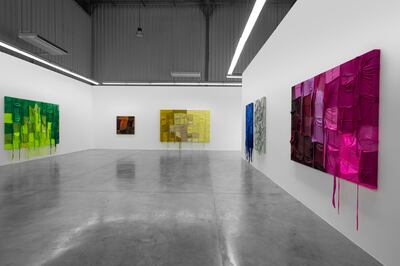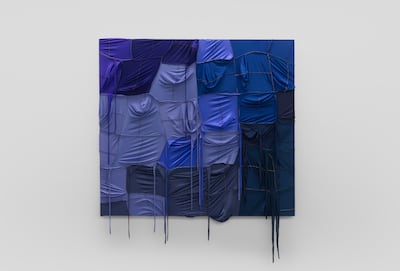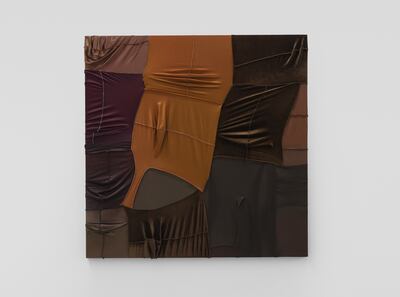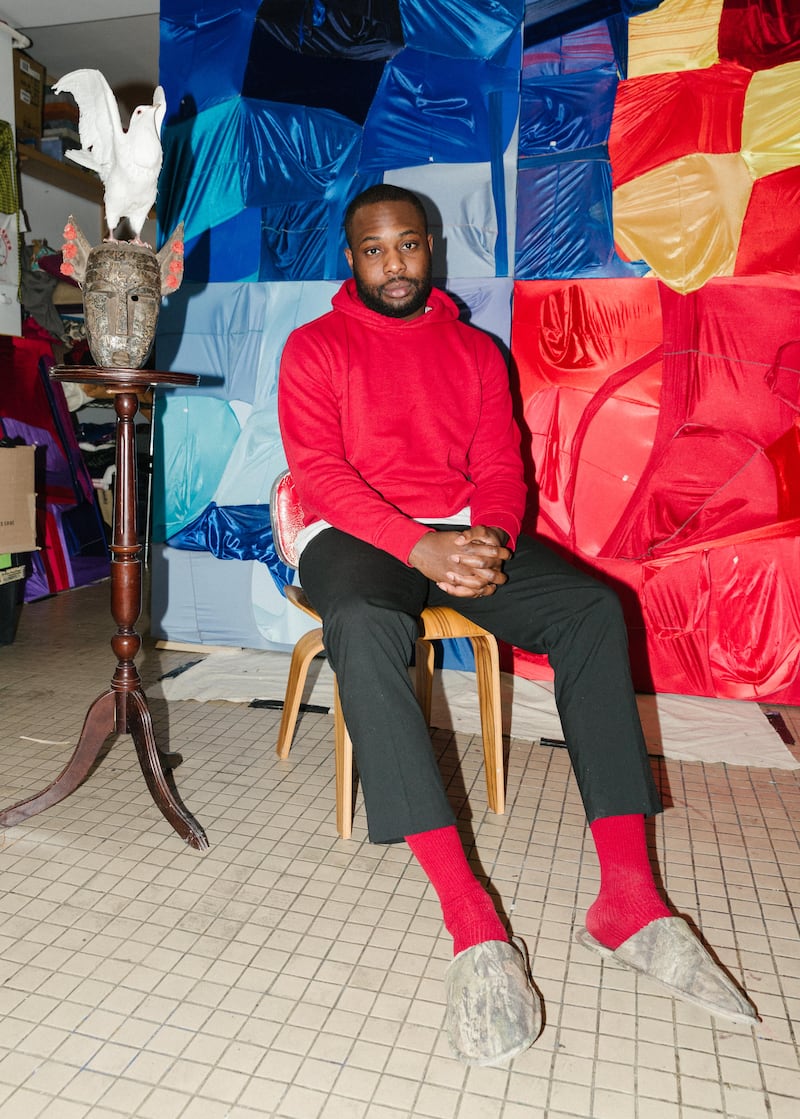To define the durag as a piece of cloth used for styling and maintaining hair would be correct, but incomplete. Yes, it is a type of headwear predominantly used to protect and style waves on black hair, but it is also, in the US specifically, a celebrated and complex cultural symbol wielded in music, fashion and even art.
For artist Anthony Akinbola, it is material. His series titled Camouflage is made up of durags, composed in various tints and shades. The cloths are stitched together, stretched, stapled on canvas, with some inside out and others loosely rippling.
“I like that I’m able to frame these works in the conversation of painting,” Akinbola says. “There’s a subversion of power that I’m interested in. By positioning these as paintings, I’m able to upset the conversation around painting, which in the past has been elitist.”
Akinbola, who is from Missouri and was born to Nigerian parents, is presenting his first solo exhibition at Carbon 12 in Dubai, where a number of his durag paintings are on view for the show Thanks A Million, which runs until November.

Working in the tradition of readymades, the artist builds his practice on found objects and what he calls “unpacking the material”. He often begins with scavenging for items that have histories he can excavate. “I was always interested in being able to re-contextualise objects,” he says. “I would pick an object and do research on it. I would find its origin and see how I can manipulate the material, critique its origin or something it’s associated with.”
The story of the durag’s invention is not entirely clear. It may have its roots in headwear used by African slaves in the 19th century to keep their hair in place as they laboured. From the 1930s to the 1960s, black men and women were fashioning types of head coverings from handkerchiefs, scarves or women’s stockings. The durag in the cut and shape that we know it today – with strings to tie it in place and a cape at the back – came about in the late 1970s.
In Akinbola’s works, the original object does not maintain its hooded shape, but its textures of shiny silk and lush velvet stand out, as do the colours and how the artist harmonises them.
The work Camouflage #055 (Jude), for example, presents varying brown tones – patches of shiny copper, amber and cocoa, skin-like and sensual. Camouflage #053 (Neptune) is also alluring, its alternating pockets of blue shifting from light to dark across the canvas.

Though these have not been included in the show, Akinbola has also made all-black durag works that are among the most striking in his series, not only for the size – with one measuring about six metres across – but also because monochrome brings the textures and shapes into focus. The artist has constructed something else out of the durags: a matte, vast, agape portal.
It’s all part of the artist’s intention, for the paintings to sit on the edge of the recognisable and the accessible as the everyday object, now transformed, opening up a way to discuss colour, composition and light.

His process isn’t always the same. Sometimes he methodically lays out the cloths and stitches them together. Other times, his approach is spontaneous, “more about feeling”, stapling durags directly on to wooden panels, building and rearranging as he goes.
With the ascendance of hip-hop and rap in the 1990s to 2000s, the durag gained even more visibility outside of black culture. Rappers such as Jay-Z, 50 Cent, Nelly and Cam’ron all sported it. Akinbola suggests that this popularity may have been limited to pop stars. “It has become more acceptable as it relates to fashion and hip-hop, but the durag, with its proximity to blackness, was also used to vilify its wearers,” he says. Individuals donning it, he says, were labelled “hyper-aggressive and hyper-masculine” and “associated with criminality”.
For the object to transcend these associations and instead become a material in art, for it to exist outside of shops and instead hang in galleries, is the subversion Akinbola seeks.
Over the years, the headwear has been brandished as a sign of cultural pride, a way to present a kind of identity. In 2018, Solange Knowles wore one to the Met Gala. Themed Catholicism that year, Knowles braided her hair in a halo that emerged from a black durag with the cape flowing down the back. Superstar Rihanna has worn different styles, including a crystal-studded one and a plain black one for the cover Vogue magazine. In art, the durag has yet to appear as much.
The measure of how subversive his work is, then, relies in how the viewer understands the durag and its cultural significance, how it has been used to signify different meanings inside and outside of black communities, and whether it is the right object to use, considering its varied reputation.
Embedded in the artist’s work is also a critique of the commodification of black culture and the globalised nature of modern-day production, with the artist exposing the “Made in China” tags for some of the durags. This rise in marketability has also allowed the artist to have more choices in his material. “There’s more consideration for black consumers. It used to be just black, white, maybe red and blue, but now there’s a range. In polyester and fine silk, too,” Akinbola says.
The durag, like other parts of black culture, including vernacular, music, style and fashion, has also been appropriated, according to the artist. “There is a fetish to the object. There’s an idea of achieving that status or style. The object has utility and has a certain purpose, but it is also able to be co-opted in that way,” he says.
The artist steps outside of that to give the object a beauty it did not always have. By detaching the durag from the wearer, the artist gives viewers a chance to rethink our presumptions about this piece of cloth and the head it sits on. He also brings the intimacy of the everyday, entangled in personal items that are overlooked, to the public space, directing us to see in new ways.
Thanks A Million is on view at Carbon 12 in Dubai until Thursday, November 4. More information is at carbon12.art






